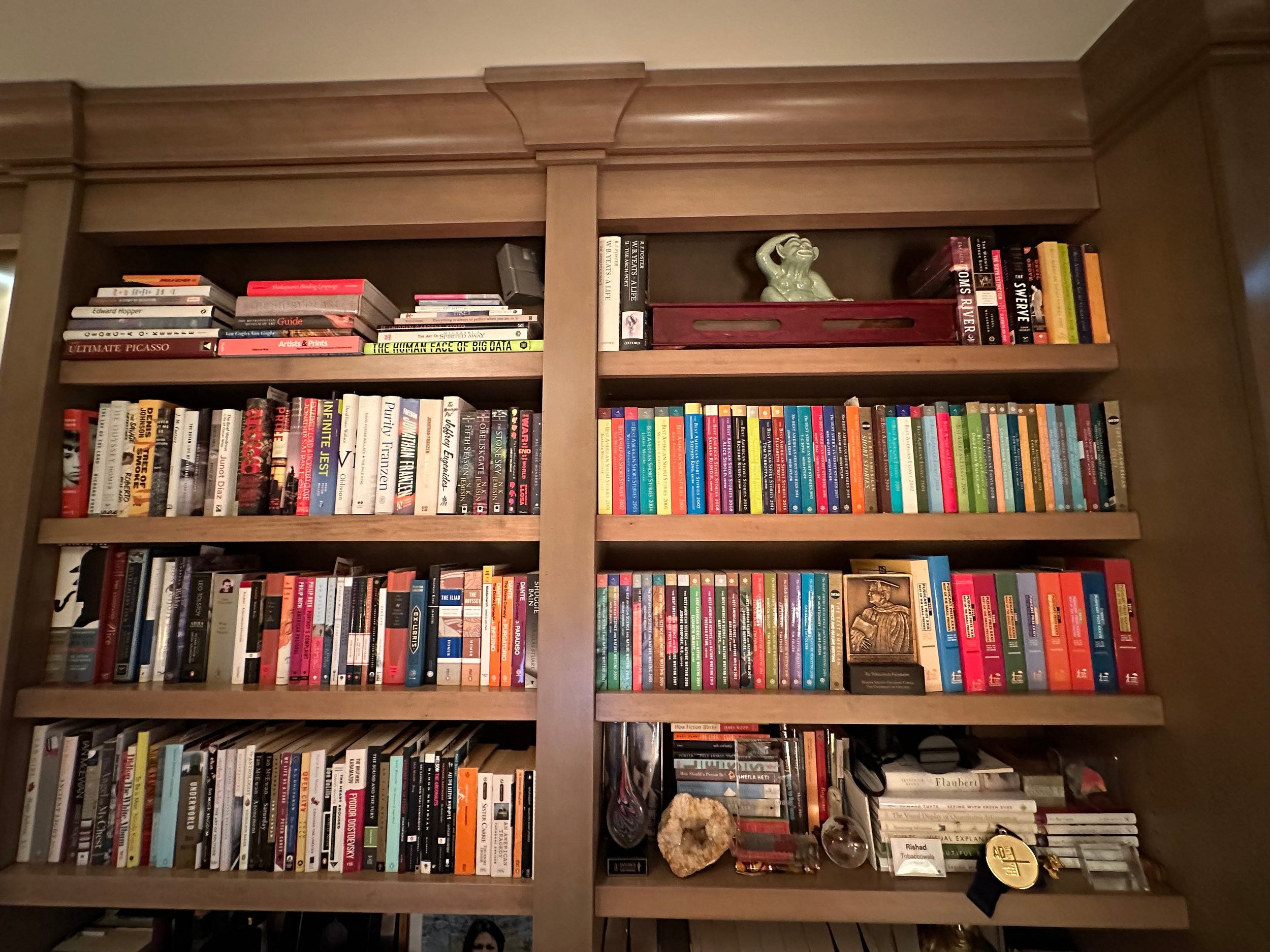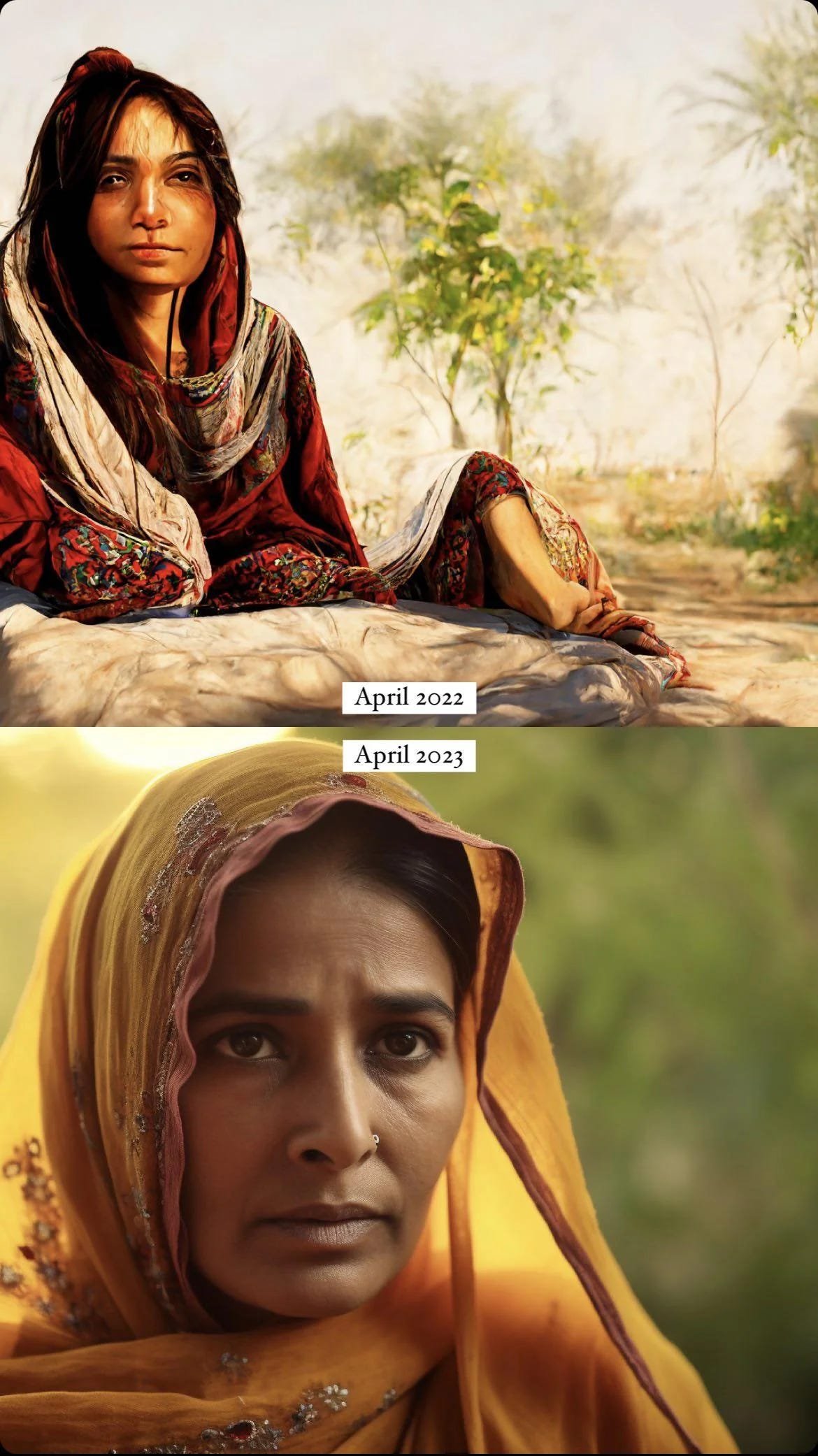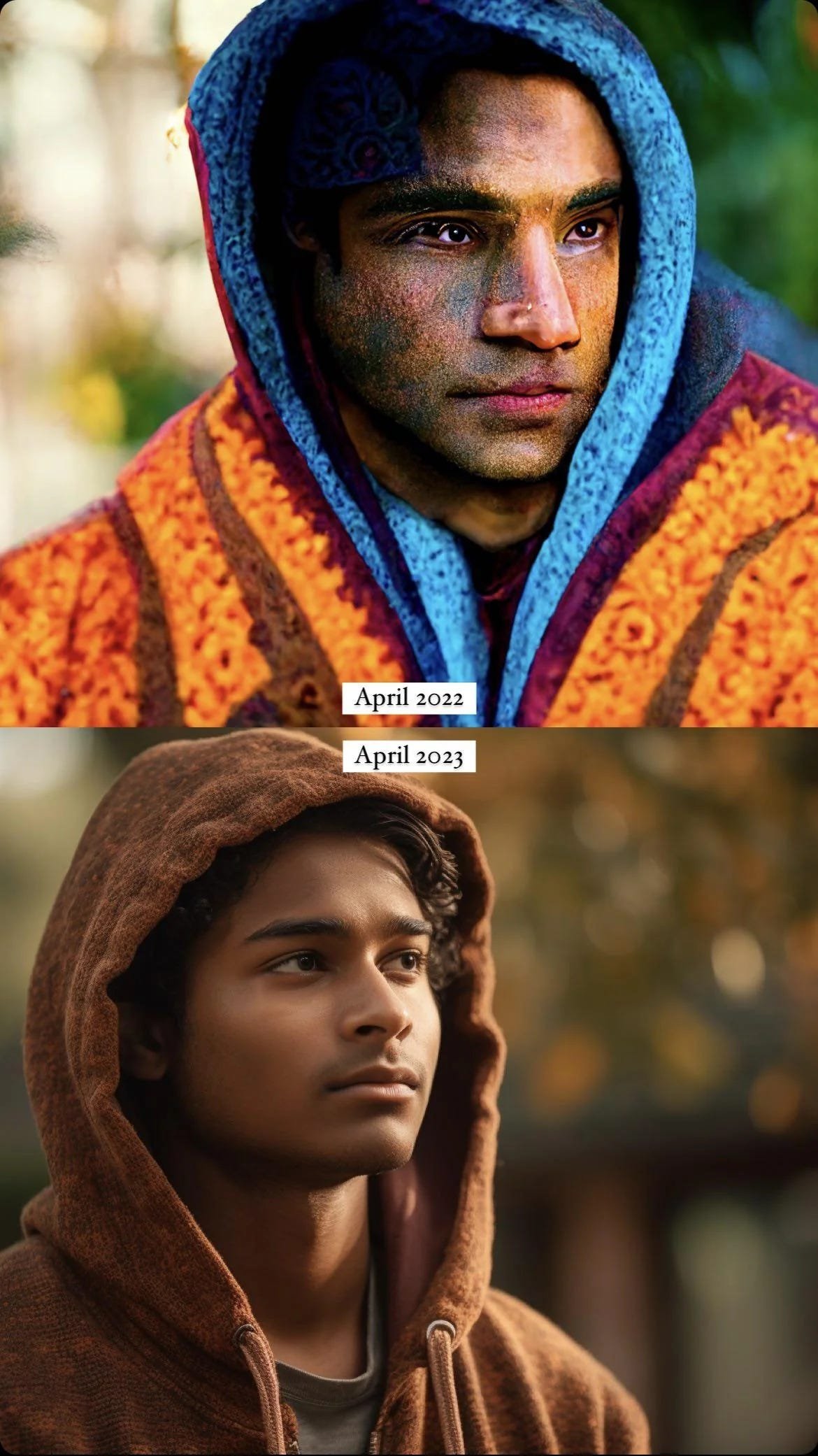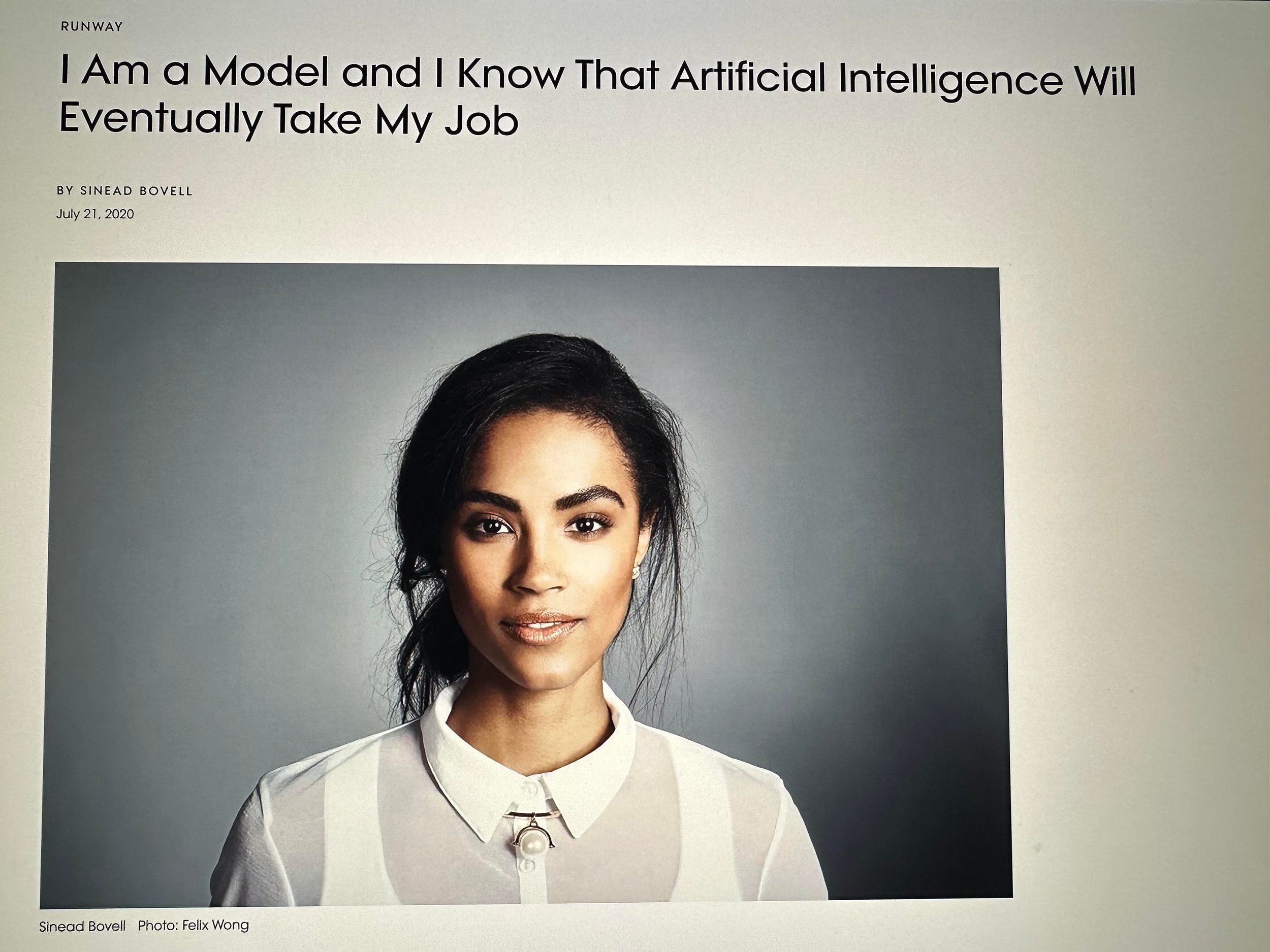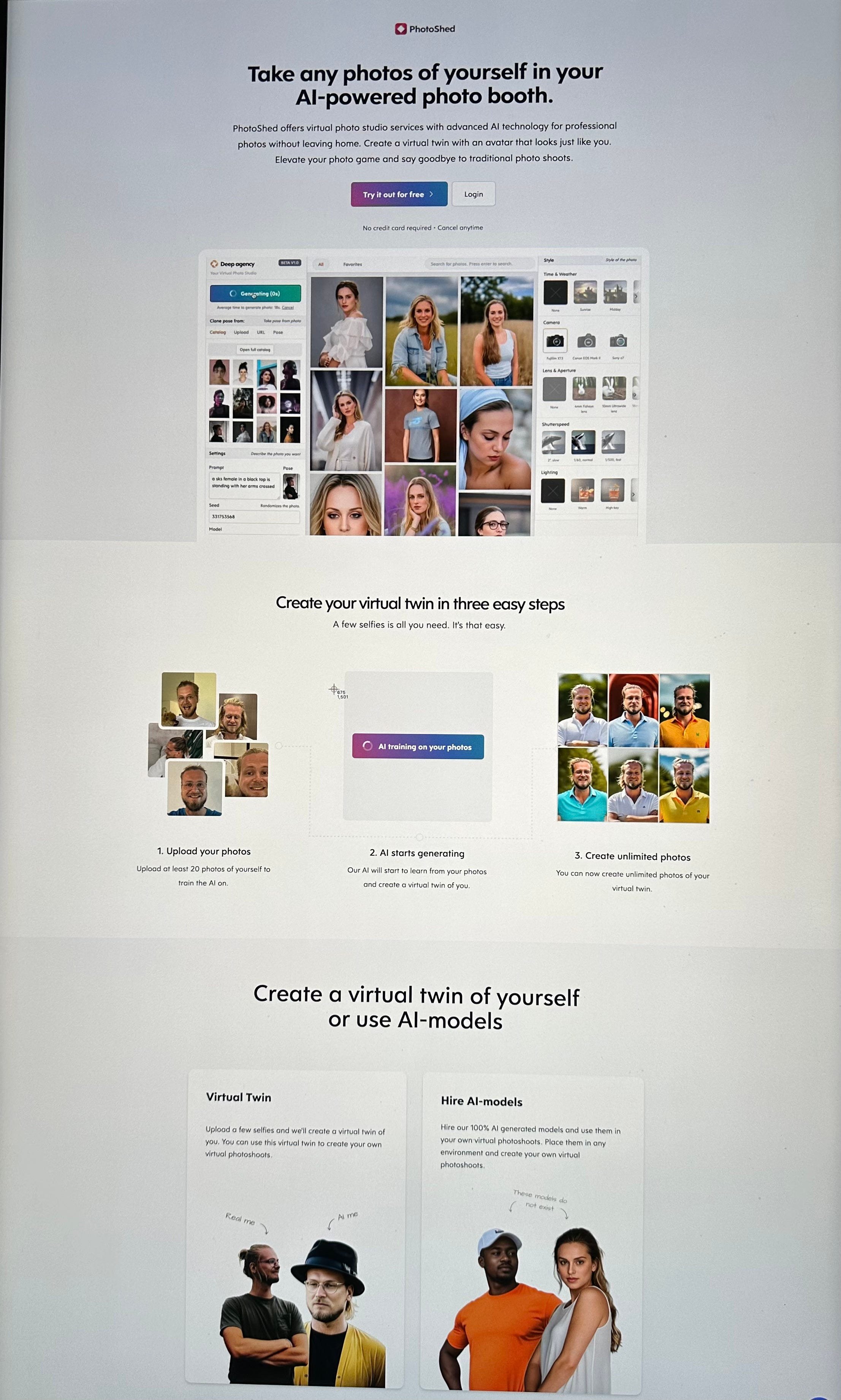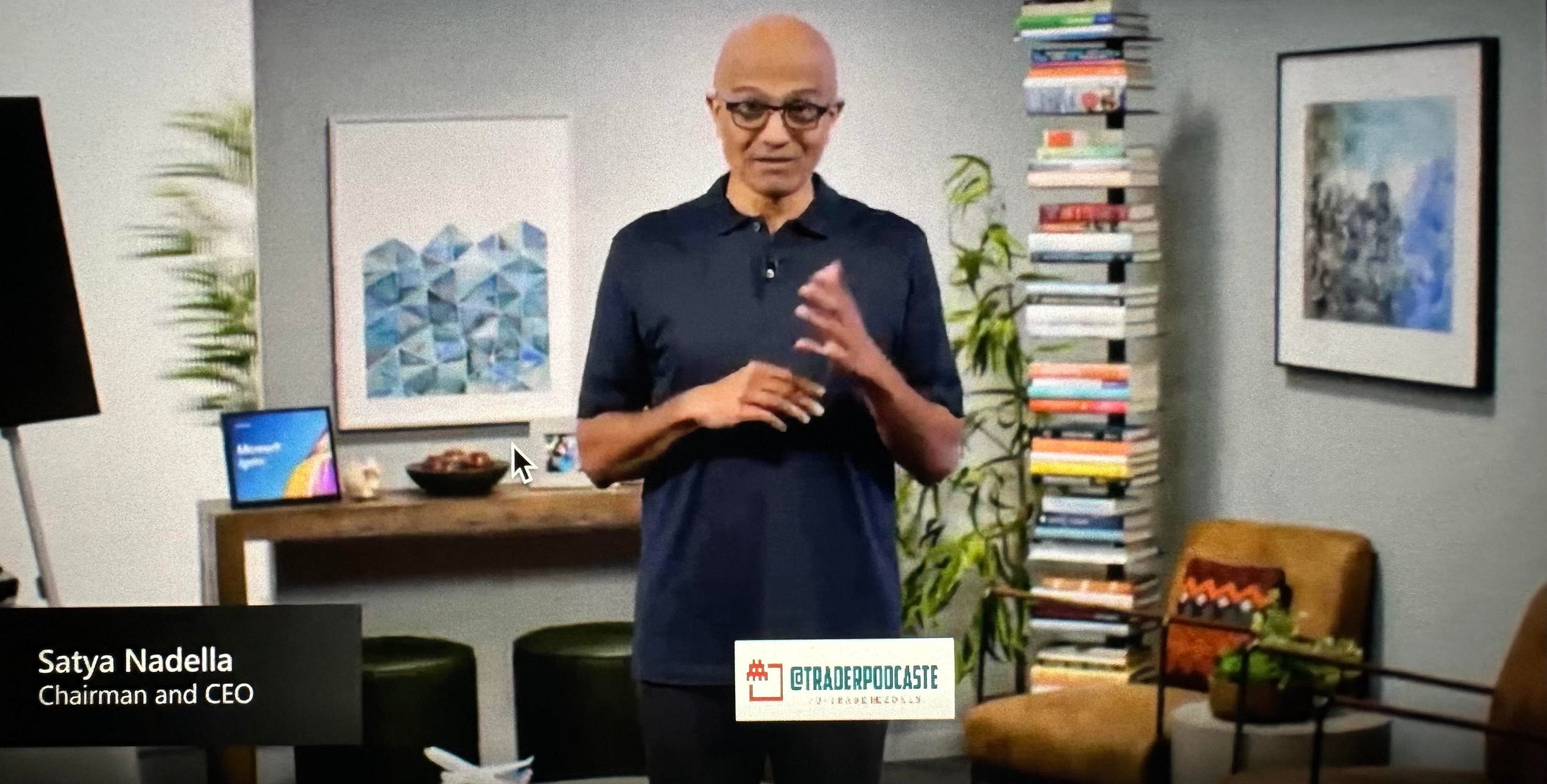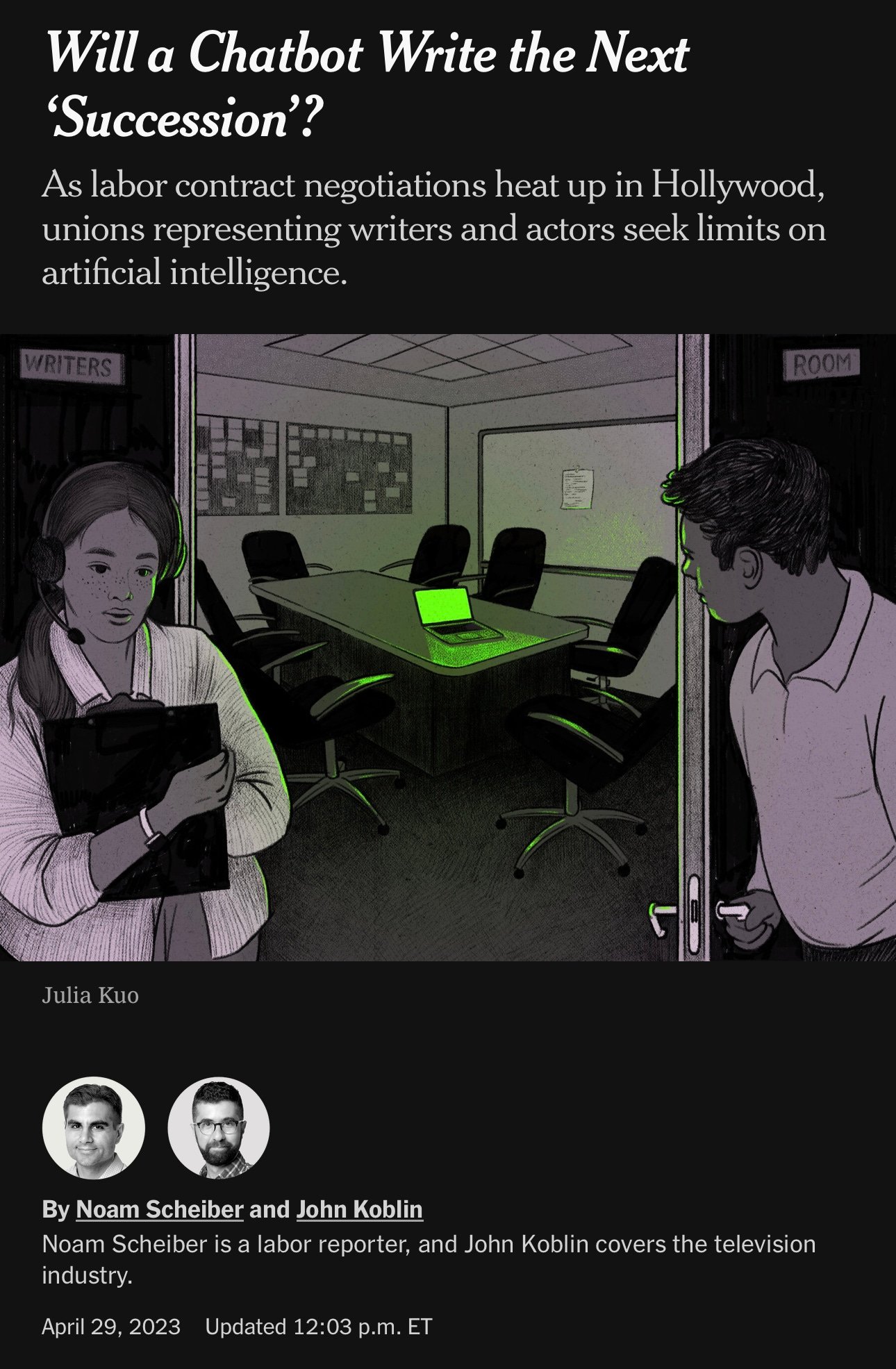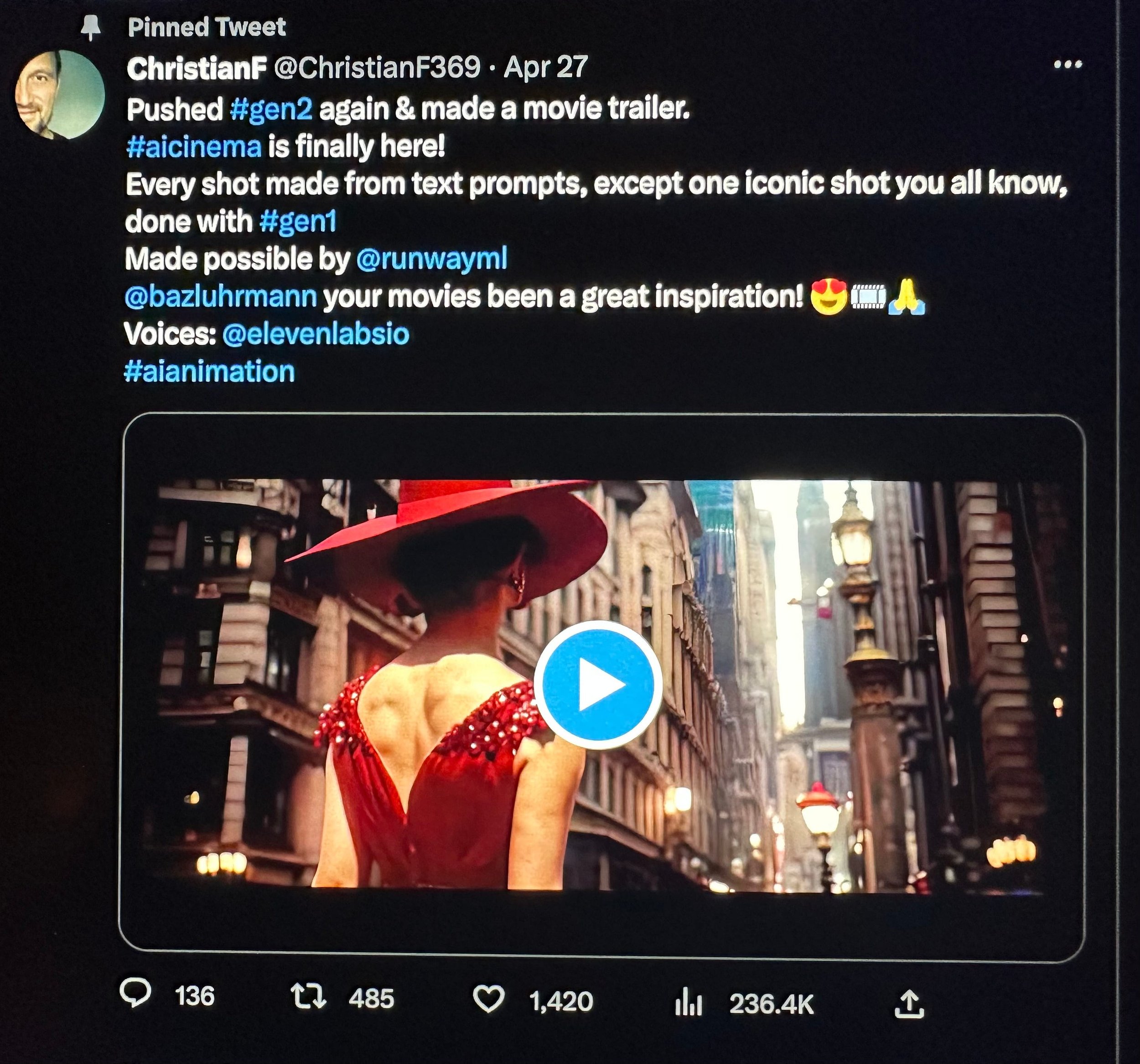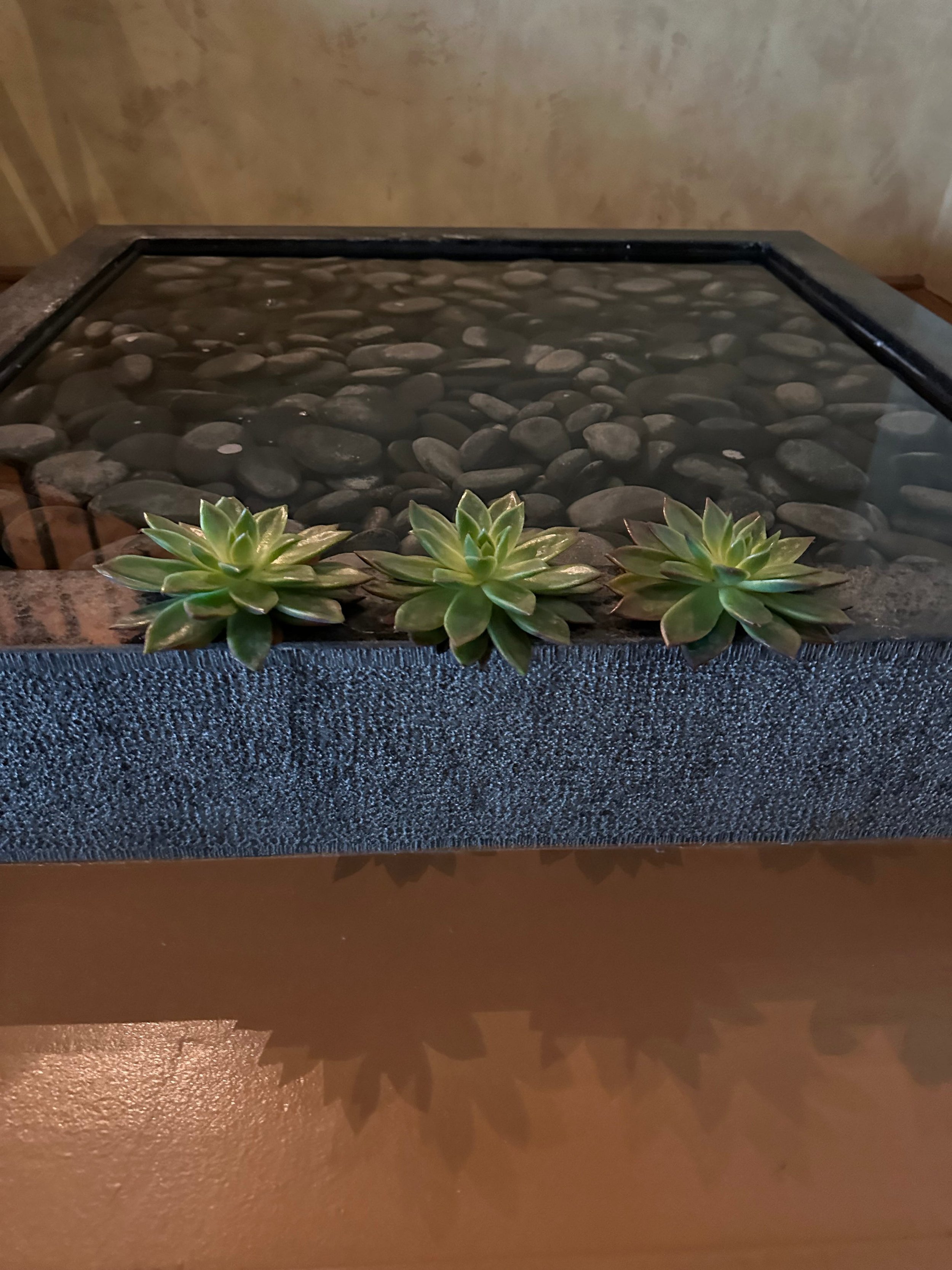On Reading.
Photo “ The Reader” by Alex Timmermans
Today’s Large Language Models (LLM’s) which drive AI advances like GPT learn and grow through “reading”.
They ingest large data sets and then connect dots, “see” patterns and create relationships while optimizing against learning goals.
“Reading” grows their capabilities which allow them to “write” their responses. We respond with shock or awe when we read what “they” write.
Writing and therefore being able to pass on knowledge from generation to generation and accessing such knowledge via reading is what has enabled humanity to grow.
Even today in a world of multi-media such as movies and games or wonderful Broadway works like “Hamilton” the key is the script and the story.
It has been said that “stories are data with a soul”
Today, GPT reads widely and then observes our reactions to help us grow (though like any reader who switches between genres they can move from non-fiction to highly speculative fantasy disconnected from reality!)
These days we hear people saying the machine is “hallucinating” but for us humans too “reading is a form of dreaming” which takes us out of ourselves.
The Case for Reading.
Reading allows us to be other people and a good writer makes us inhabit another character.
They make us better understand others and better understand ourselves.
David Foster Wallace wrote “ Good writing should help readers be less alone.”
Often a good book will give you “you” as the writer evokes what you feel better than you have the words to express the same thing..
It makes us less lonely and lets us live simultaneously in yesterday, today and tomorrow, and inhabit places here and there, becoming people that are free from our physical constraints.
“Writers have not taken us anywhere but they have taken us everywhere”
George Martin wrote “A reader lives a thousand lives before he dies . . . The man who never reads lives only one.”
Reading also changes us.
“The best books are like surgeons. They change you but you do not remember them and they do not leave an external mark.” but even then “A great piece of writing is one that you feel on your skin.”
“A story is simply a sequence of language that produces a chemical reaction in our bodies.”
But they have a unique long last effect because while “Drugs get flushed from our system but not the best stories.”
The Case for Books.
Today due to the Internet and enabling platforms from Substack to Wordpress everyone can access more voices from more places with more diverse backgrounds than ever before.
Some of the best reading is self-published and can be obtained far from the big publishing houses of the West.
Short form or long form. Listened to or in the reflected glow of a Kindle. Words by themselves or a piece of writing encrusted with links and multi-media can all transform.
But one great way but clearly not the only way to read is through an ancient “ interface” of a physical soft cover or hard cover book.
While it cannot illuminate itself allowing you to read under starlight or allow one to hold a thousand books in the palm of your hand there is something tangible, mystical and spiritual about a physical bound book.
The utter simplicity.
Black symbols on a white background which create an alchemy of feeling, unleash our imagination and spur growth in their own unique way distinct to each reader. Personalized magic that all modern tech seeks to replicate but has not yet.
They might one day if they learn from reading.
Less is more.
Life is infused with meaning because of the reality it ends.
Data is not wisdom.
Humans are unpredictable, inexhaustible and illogical .
One could do no better than watch Chip Kidd speak about the “thinginess of books” to make you newly appreciate these objects in which knowledge has passed down the centuries to intersect with us sometimes so powerfully that a book can leave us thinking “I must change my life!”
Many are lucky to own hundreds of books often decades old. Many yellowing. Most marked up with exclamation marks reinforcing the writer or quarrels with the author in angry scribbles in the margin.
Some tattooed with stains of spilled food or some mishap on a plane or train or other accelerating or braking vehicle from a journey in the misty past.
Artifacts encrusted with meaning.
Citadels to memories.
When we revisit them like many readers we wonder why we underlined the lines we did.
The book did not change.
We did.
“Life is a river and we cannot step into the same book twice”
Lots of things in life change us. Memorable experiences. Transformative relationships. Amazing people.
But the books we read impact us deeply too.
As a reader wrote “ Its only reading. By which I mean it’s everything”.
Is it Human or is it AI?
12 Months of Progress of AI responding to the same prompt for an image on Mid-Journey.
Remember the Memorex Cassette tape ad with Ella Fitzgerald where Ella recorded on Memorex still shattered the wine glass? When one heard her voice was it live Ella or was it taped Ella?
Today we cannot tell whether AI generated images are real or not.
See above for the AI generated image using the same prompt one year apart.
These are not photographs but machine generated images created by mixing and merging data using text prompts
See below for another example.
If Force is equal to Mass x Acceleration with AI we are seeing Mass in hundreds of billions of dollars of investment globally and acceleration of doubling capabilities sometimes within three months. For instance Chat GPT which is GPT 3.5 scored on the 10th Percentile in the Law School Test. Six months later GPT 4 scored in the 90th percentile! Moore’s law of the processor age of doubling capability every 18 months is so snail like slow compared to what we are seeing.
AI is a Force that appears to me to be more impactful than the World Wide Web and the iPhone multiplied by 2.
Three years ago Sinead Bovell a model wrote an article in Vogue predicting that AI would take her job. That time she believes is here.
Earlier this week she was on the a16z podcast along with Danny Postma and if you are in any part of the marketing, creative, production, e-commerce or media business take a listen.
In this episode, Sinead Bovell and Danny Postma discuss the transformative impact of artificial intelligence on the world of modeling, online creation, and self-representation.
From the rise of AI-generated photos to the democratization of creativity, they discuss the potential of AI in shaping the future of digital expression.
If you want to try these tools click below for Danny Postma’s projects.
Below is just one of more than two dozen projects and tools
The economics of these new tools and the ultra- reality and speed of the output will unleash some of the biggest tsunami’s in the creative and production industries starting now. This is not the future. The future is here.
Every leading firm is already incorporating these tools into their workflow to build upon and add value.
Deepfake Videos driven by AI.
An amazingly fun (and disturbing since it looks and sounds so real) video of Satya Nadella putting Gates, Balmer as well as other Indian tech CEO’s in their place and ending with the following rap was released a few hours ago:
“Because this fella,
Satya Nadela,
the rocket propella,
will take Microsoft Interstella.”
Click below or here to watch….you will both be amazed, terrified and possibly pass out laughing…
AI Clones
The WSJ tech reporter cloned her voice and image and sent her avatar into interviews to confirm her security to JP Morgan Chase and into meetings.
The Avatar succeeded some times and failed at other times.
Watch the video above or click this link:
But as we saw with the AI imagery advancements in the past year, the speed of enhancement and improvement is such that it will be less than a year before we may ask:
Is it live or is it AI?
AI and the Creative Arts
The New York Time had an incredibly interesting article ( also read the comments in the comments section) that must be read in its entirety to understand how AI is not just going to impact finance, tech, accounting and other left brained, quantitative, mechanical and mathematical industries but the very heart of creativity and storytelling!
Here are four paragraphs from the article that snapped me to attention:
“It is not out of the realm of possibility that before 2026, which is the next time we will negotiate with these companies, they might just go, ‘you know what, we’re good,’” said Mike Schur, the creator of “The Good Place” and co-creator of “Parks and Recreation.” “We don’t need you,” he imagines hearing from the other side. “We have a bunch of A.I.s that are creating a bunch of entertainment that people are kind of OK with.”
In December, Apple introduced a service allowing book publishers to use human-sounding A.I. narrators, an innovation that could displace hundreds of voice actors who make a living performing audiobooks. The company’s website says the service will benefit independent authors and small publishers. Other actors fear that studios will use A.I. to replicate their voices while cutting them out of the process. “We’ve seen this happening — there are websites that have popped up with databases of characters’ voices from video games and animation,” said Linsay Rousseau, an actress who makes her living doing voice work.
SAG-AFTRA, the actors’ union, says more of its members are flagging contracts for individual jobs in which studios appear to claim the right to use their voices to generate new performances. A recent Netflix contract sought to grant the company free use of a simulation of an actor’s voice “by all technologies and processes now known or hereafter developed, throughout the universe and in perpetuity.”
On-camera actors point out that studios already use motion capture or performance capture to replicate artists’ movements or facial expressions. The 2018 blockbuster “Black Panther” relied on this technology for scenes that depicted hundreds of tribespeople on cliffs, mimicking the movements of dancers hired to perform for the film. Some actors worry that newer versions of the technology will allow studios to effectively steal their movements, “creating new performance in the style of a wushu master or karate master and using that person’s style without consent,”
There is a lot more in the article including a strident defense of the superiority of emotion and the unique ability of humans to have ideas in the article.
But we ain’t seen anything yet….watch for text to video and much more
Prompt to Text is GPT. Prompt to Image is Mid-Journey/Dall-E2 and more. Now Prompt to Video!
Runway ML is a company that is a pioneer in this area. Click on the video above and you will not believe your eyes as to what is now possible with AI.
The ability of individuals to produce pretty high quality video’s with current technology is just a start. The tools are getting far better, far easier to use and far cheaper to access.
But wait that video of Gen 1 was 2 months ago which is a lifetime in AI time. Gen 2 is out and here an example from earlier this week of video completely made from text prompts except for one shot.
For an example of the rate of change and quality of what is possible read this tweet:
It is called The Great Catspy!
Click here for the video or the link below:
https://twitter.com/ChristianF369/status/1651607149804498946?s=20
The Future is Human Plus AI.
Everything I have shared is what I read or discovered in my “learning hour” this morning ( as people know I believe if you are not spending an hour a day learning it is game over for most of us regardless of our experience, status or seniority.)
I am convinced that AI is moving faster and deeper across more industries than we can imagine and it will impact everybody’s job in some way small or medium in 2023 and will begin to have a significant impact in 2024.
History suggests that every advance in technology places a premium on superior ability and talent will matter. However what talent does will shift as technology changes the nature of jobs and industries. There clearly will be a lot of creative destruction and many wonder if it will only be creative destruction versus new industries, new jobs and new opportunities.
While the future is hard to predict there is no doubt that AI can make all of us more productive by 10% or more right away and unleash break throughs in medicine and several sciences. It also will provide more people with more tools and canvases to tell more stories in new ways.
It will help us grow as long as we grow our learning alongside these advancements.
Career Bending Times.
Photography by Alex Timmermans
These are career bending times.
A fusion of forces in the forge and furnace of the future that reshape many fundamentals of our careers.
Whether we are early or in the middle or more senior in tenure.
Whether we work for a small, medium, or a large firm.
Whether we are self-employed, a free-lance or a “full-time” employee.
Regardless of our industry, our country, or our expertise.
Photography by Alex Timmermans
The Forces.
There are six forces each of which might have changed the contours of our career which are all occurring at the same time, are intertwined with each other, and are becoming increasingly powerful.
1. Demographic Change: Four generations at work. Major mindset differences between youngest and oldest generations. Aging and declining populations everywhere but Africa. Today the largest increases in working populations are over 60 years old. And 62% of Gen-Z have a side- gig, side-hustle or passion project while working full-time!
2. Technology: 5G, Blockchain, AR/VR, AI, Biotech and much more. Today AI and its impact are resonating everywhere but make no mistake while it might be the “Next New Thing” there is much more coming.
3. Multi-polar globalization: Globalization but with different centers of power including China centric, India centric, Euro centric and US centric zones of influence and virtual borders versus a seamless connected world.
4. Unbundled and Distributed Work: The world of five days in an office will be the minority of service jobs leading to new questions about culture, management, career growth.
5. Work/Life Reset: One long term impact of the 2020 to 2022 trauma was as someone wrote: “And isn’t this the whole point, post-Covid: to actually live your life?” Many people who believed work was life now believe work is an important and key part but just one part of a well-lived life.
6. The melting, decaying, and liquefying of industry shapes and boundaries: With Apple offering 4.15 percent interest on a FDIC insured savings account up to 250,000 dollars that you can fund with one click and loaning you funds from their balance sheet with their Buy Now and Pay Later program they are for all purposes a bank. Walgreen and CVS are shape shifting into not just providing pharmaceuticals but health care. How long before “The New York Times” discontinues its slogan about “all the news fit to print” because it is increasingly a multi-media everything brand which might soon stop printing newspapers?
Each of these forces are intertwined with each other. Modern technology and marketplaces allow for side-gigs and side-hustles and unbundled work. AI powers Biotech and re-configures jobs. New trade barriers move jobs and manufacturing to different countries as does the rise and fall of population.
Photography by Alex Timmermans
The Career Implications.
While the future is often hard to predict one can be quite sure that in the next few years the current waves of change will grow into a tsunami, and everybody will be impacted in some way or the other.
1. We are now going to have 50-year careers: Extended life spans, limited government pensions, incentives for elder people to stay in the workforce, machine enabled work will have us working for multiple decades versus a 30-year career.
2. Life-Long Training and Education: Even three decades into a career well into the 50’s one may need to go back to school, re-skill and re-tool. And the days of saying “We will be retired before all these new things happen” will not be realistic. Investing in continuous learning will be key to stay relevant.
3. We will increasingly be working like gig workers and there will be many other changes to the design of organizations: A job will not be a title, a position and a static role but a constantly changing number of tasks, outcomes and deliverables In a globalized and connected marketplace of unbundled and distributed work we will all become gig workers even if we spend long time in a firm since all firms will become increasingly agile and connected, looking to put the best people on the most appropriate tasks very much like the way Hollywood or TV production works.
4. We will be work in tandem with machines: Almost every job will become AI or Web3 immersed or infuses with some other technology. The productivity increases of modern technology will mean no one without modern technology will be able to compete.
5. We will work in smaller and delayered companies with many of us operating as “Companies of One”: a) AI software, b) Platforms that enable access to marketplaces and talent ( Shopify, Fiver) , c) a need for shapeshifting agility as categories re-invent themselves ( Finance, Auto, Healthcare, Education at a minimum which account for half of US GDP), d) a demand for flexible cost structures in a high velocity world, e) a work-force where free-lance workers are greater than full-time workers (2025 in the US) and f) scar-tissue of over hiring (see tech and media companies today) will significantly reduce the size of most companies, eliminate multiple layers and focus on experts and deliverables versus generalists and process.
6. Leaders and Coaches and Learners versus Bosses and Manager and Know it Alls: In this new world people will likely value, ask for and measure three things:
a) what does an individual help make, build, ship, change or impact?
b) what value do we add to the machine or how do we collaborate with other people or plug into a role on a project so that 1+ 1=3 ?
c) what creativity, vision, empathy, or imagination do we bring to inspire and grow people and business ?
The key will be how one can lead, train, and grow talent to unleash their potential.
The big corner offices, the gauntlet of handlers, receptionists, and other awe-inspiring fear mongering scaffolding of the pre-2020’s will all be seen as the crutches of the insecure and the fearful causing most talent to rapidly re-route around such blockages and blockheads.
People’s “zone of influence” and “zone of impact” will be far more important than our “zone of control” or “size of kingdom”.
Photography by Alex Timmermans
Re-inventing and Staying Relevant.
A complete re-imagining and re-thinking is underway which is why all of us feel some combination of fear, challenge, excitement, and even horror!
The drumbeats of a changing reality are beating in the marrow of our blood even if we do not wish to listen to their forceful thump-thump…
We will all need to bend ourselves into new forms, skills, and shapes.
A few keys to remaining relevant will be:
a. Plan for the long term: Plot careers over phases recognizing different eras as well as our own differences as we age with a look both ahead and behind. Read 12 Career Lessons a distillation of my learnings on re-inventing over time.
b. Build expertise. Hone a craft. Be known.Learn and earn a niche or niches. Have a voice and learn to tell a story. Read Career Turbocharging for an exercise if you are looking for a job, thinking of switching jobs or re-inventing yourself and a job.
c. Do not outsource your career growth to anyone else:Be responsible and control the upgrading of your mental and skill operating system to keep on learning.Here is one way: Learning to learn.
And here is one page with thoughts on a dozen topics to thrive in the future you may wish to bookmark. Look at Section 8, 9 and 10 in particular.
It will be a career bending time.
Which is far better than a career ending time!
On Purpose.
Ipsos publishes an award-winning strategic foresight magazine called “What the Future” . Matt Carmichel, What the Future editor and head of the Ipsos Trends & Foresight Lab, recently spoke to me for an article about Purpose which this post is built on.
What’s the state of purpose today?
There are three ways to look at it.
The first is that Purpose is a core differentiator. A survey by Deloitte indicates the following
“Purpose-oriented companies have higher productivity and growth rates, along with a more satisfied workforce who stay longer with them.5 Our research shows that such companies report 30 percent higher levels of innovation and 40 percent higher levels of workforce retention than their competitors.6 While traditional trends might dominate purchasing behavior, new opportunities exist to connect with customers through purpose.
In 2019 consumer survey showed that price and quality remain the biggest factors driving customer decisions.7 However, many of the same respondents (55 percent) believe businesses today have a greater responsibility to act on issues related to their purpose. Those failing to do so risk being displaced by purpose-driven disruptors. For example, Unilever’s 28 “sustainable living” brands (i.e., brands focused on reducing Unilever’s environmental footprint and increasing social impact) such as Dove, Vaseline, and Lipton delivered 75 percent of the company’s growth and grew 69 percent faster on average than the rest of its businesses in 2018 (compared to 46 percent in 2017).8 Soap, petroleum jelly, and tea are everyday household essentials, but by promoting sustainable living, these products became differentiated as they embody the company’s purpose.”
It is interesting to note that Unilever has not done well recently and changed management which make many believe that purpose can be overplayed.
On “What Next?,” a podcast I host we recently had two different guests talk about purpose and each provided a different perspective.
One was from Thomas Kolster who basically said, “Forget everything you know, about brand purpose.” His basic belief was that businesses are now trying to position themselves as heroes, but they're not heroes. Customers are heroes and they say, “This is my purpose.”
This second perspective is yes purpose is important but forget brand purpose and align with customer purpose.
The other was from Steve Harrison who believes that purpose is over-hyped, that companies have forgotten that they exist to make things, sell things and create jobs. Anything that makes them not remember they're providing jobs, selling things, and making things and instead come up with social concoctions means they have lost the plot.
This third perspective is purpose is bunk. Make things. Create jobs. Ship things and stop all the mumbo-jumbo.
Why purpose is important but needs to be nuanced and authentic.
For most firms reality lives between these perspectives.
Purpose is important because it is one of the “whys” that Simon Sinek says a company needs.
Purpose is also important to attract and retain talent.
People are very interested in what the purpose of the company is, even if the purpose is “We make great products.”
Many people are now looking not just to join a company not for money, fame or power, which is important, but for companies to have purpose, values and connections.
But a company should be very clear that when they are identifying a purpose, it has something to do with their industry.
If it sounds bombastic it will bomb.
Authenticity is key which means tight and believable scope versus “we are here to save the world” that gets everybody who is in the real world either rolling their eyes or shrieking with laughter.
Businesses and Brands are stepping into an unfortunate void.
People are looking to brands and companies to solve problems because they have decided to give less credence to media and government.
If media and government did their jobs, we wouldn’t look to brands and CEO’s to fill in!
The purpose trend and the need for CEO’s to increasingly take positions way outside their business and expertise is due to a crisis of leadership.
A breakdown of trust and a refusal to see the world as it is.
If leaders actually led, which means identify reality, fixing problems, and delivering products and services, people would not say, “What about purpose?”
That is their purpose.
Fix problems. Think long term. Look after people. Ship product. Build infrastructure. Create jobs.
Why Purpose is hard.
Often it is Ben and Jerry or Patagonia or Unilever that are trotted out for case studies.
There are many other examples too but not too many that resonate and ring true because it is difficult.
Purpose is principles.
If you're principled, you’re going to do things that will potentially hurt your career, hurt other people, or hurt financial performance because you decide to say, “That doesn't fit my principles.”
Those brands take a stand and the stand pisses off certain people.
What a lot of companies today are doing is adding purpose because they don’t want to piss off people, which is the exact opposite of what purpose is.
Purpose is taking a stand!
But too often it is a thin veneer of paint on the surface and and not deeply intertwined into the internal brand and company architecture or culture.
Areas that brands can align with which are critical but not politically fraught.
There are three places that brands can help that aren’t politically driven.
Helping people grow old: All over the world except for Africa every country is aging fast. The elderly or the “seasoned” in many countries have many challenges from companionship to the need for medicines to financial constraints.
Everybody regardless of one’s political affiliation, sexual preference or gender identity is going to grow old.
Helping people who are hungry: Organizations like Feeding America to local Soup kitchens to Food banks to School programs all serve humans in need. People in need. Regardless of ones beliefs.
Helping people learn: Brands and companies have great resources not just in money but the talent in the companies, technology and much more. Today like never before learning is key. And learning can be everything from internships to mentorship to coaching and much more. Most countries and areas are struggling with education which in many cases is too expensive, too degree oriented and too exclusionary. Imagine what any company can do in their markets to lift peoples skills which helps both the people and the company by having more people to hire.
What will purpose look like in the future.
Often today purpose is like soufflé at a fancy restaurant. It's basically puffed sugar like expensive candy floss. And a firm often has many purposes all different flavors of candy floss.
The future will be more single minded and unified purpose that links to your product, show how you look after your employees with it and shows customers that because of that they will feel better about your product or service.
Brands are built today on three criteria.
One is delivery of benefits. If you clearly can do something particularly well, that's what you're supposed to be doing. Authentic. Real. Aligned with the business.
The second is purpose will require one to have happy employees. Companies who do not look to create joyful employees will not be believed about some mumbo jumbo purpose. Who cares how you source your product or how you will save the climate when you care and look after your employees?
The third is, is the purpose measurably helping people feel better about your product or service?
The future of purpose, highly measurable and very much aligned with the company’s customers, employees and community.
Photography by Rishad Tobaccowala
Creative Cultures.
Photography by Michele Sons
In 2010 Kat Gordon was the rare creative director who was a woman.
3 percent of creative directors were women then and almost no one of color.
Kat decided to do something about it, and she began The 3% Movement built on the belief that Diversity=Creativity= Profitability.
Ten years later after a decade of conferences and other initiatives nearly 30 percent of creative directors were women and while there is still a way to go Kat re-imagined and re-invented the movement to be even more community and peer to peer driven.
Kat was the latest guest on What Next? where she discussed how to be “Creative about Creative Leadership”. The conversation is applicable to any company , individual or leader regardless who might be grappling with culture, creativity, combining AI with humans, the future of the workplace and much more.
Photography by Michele Sons
Creative cultures are communities of belonging held up by trampolines of trust and creative entrepreneurship.
For decades companies have run as hierarchies.
The boss has been the parent and the employees the children.
It was important to gain favor with “dad” to earn rewards and to avoid punishment.
There was the “Sun-King’ at the center with some others in the royal court and most people were after thoughts on whom no light shined.
Changing demographics, new mindsets, enabling technology and distributed work is moving power from the center to the edge.
Stars can shine anywhere.
Creativity is increasingly about teamwork…note how entire teams take the stage at Cannes.
It is about community and a peer orientation where taking risks and speaking up and making mistakes are supported by trampolines of trust versus encrusted with jagged cliffs of death.
It requires Creative Entrepreneurs who build, create, sculpt and design not just new work but new organization and ways of working.
We not only have to re-think creativity but creatively re-think the creative organization.
Photography by Michele Sons
Creative cultures like nature constantly evolve and adapt and constantly ingest, incorporate, and build on new technologies.
The 3% Movement changed the way they work, and their focus based on new technologies, new ways of working and new challenges.
Nature evolves. We are on the 16th operating system of the Apple iPhone. Culture changes.
Creativity by definition is about the new, the fresh, the insightful, the not done before!
Moving hearts and minds, building brands and telling stories have changed as we moved from word to audio to film to digital to multi-media.
Modern technology of prompt to words (GPT-4), prompt to image (DALL·E 2, Mid-Journey, Stable Diffusion) or prompt to video (Runway ML) are already being leveraged by the creative community to great effect in three ways:
a) Enhanced Productivity: The best creative talent is overworked and often burned out. These new technologies save time and become super assistants to them in eliminating much rote work. So many creatives will benefit from tools to help them become more productive.
b) Idea Catalysts: Now instead of staring at blank sheet of paper to start a project we have starter ideas, templates, first drafts and initial imagery to build on, add our unique value to, correct and enhance. New options will unleash new worlds of creativity.
c) New Paints and Canvases: Today Creatives have a canvas of the new immersive worlds of gaming driven by Unreal Engine, 3D frontiers of creativity where the real and virtual blend such as AR/VR as well as Mongrel Media where one can embed and combine commerce and video and much more, All of these are opening massive new universes for creativity which would not have been achievable or scalable without the new AI tools.
While change might be difficult, irrelevance is worse and talent will adapt and incorporate the new tools. Some jobs will go, and others will come but if “life is short and art is long”, creativity and the creative community will not just endure but thrive.
Photography by Michele Sons
Companies that believe in diversity should also allow diverse ways of working.
The future of how work will be done in an unbundled and distributed era while operationally challenging is creatively exciting!
Creativity is connecting dots in new ways.
Ideas can occur anywhere whether it is on a walk, in a shower or while grocery shopping.
In person interaction can happen at conferences, restaurants, bars, learning events, training programs as well as the office.
It is time for companies to be brave and not go back to the safety of what was one tried and true.
Different people have different ways they prefer to work.
Different levels of expertise need different environments and support.
Instead of being like the Mandalorian and mandating “this is the way” leaders should follow the wise words of The Lawrence of Arabia’s recognizing that “nothing is written!” and experiment with different ways.
Companies that develop and integrate a portfolio of ways of working in ways that are balanced and unified but with built in flex are likely to attract, unleash and turbo-charge creativity.
They will create cultures of innovation and potentially gain long term competitive edges.
Diversity of working styles is also diversity and now is the time for companies to try different models and then offer some subset of choices to talent.
Photography by Michele Sons
A significant number of future creative leaders will be introverts and empaths.
When Susan Cain wrote the best-selling book Quiet: The Power of Introverts in a World That Cannot Stop Talking she noted that half of the population described themselves as introverts.
But today in many industries 80 percent or more of the leaders are extroverts.
This is changing and recent developments will turbo-charge the rise of introverts and empaths so that the leadership population is more like the general population.
There are many reasons for this rise beginning with the rejection of toxic or bullying or command and control cultures. People today have just too many options to put up with nonsense. People leave bosses much more than they leave companies.
More importantly the world of unbundled and distributed work is introvert and empathy friendly since many office environments with their noise and “war-rooms” are not conducive to these personalities who prefer quiet and reflection to get things done.
More importantly in a world of Zoom everyone can be “seen”. The boss has the same square footage on Zoom as the lowest ranked employee There is no corner office equivalent of Zoom where someone’s tile is bigger (probably one reason some bosses want people back to the office).
The loud and the quiet are on equal footing.
People are more likely to speak up. Content quality, conversational ability, creativity inspired, and the community minded can thrive.
And in a world where the left-brain tasks will be increasingly done by machines there will be a great demand for empathy, emotion, and humanity to work in tandem with the machines.
Remember the Memorex ad that asked “Is it live or is it Memorex? and the orange juices that promise they are “100 percent pure squeezed”
Soon just liked hand crafted, artisanal, and traditional earns a premium price, we will be promised “100% human” while we wonder whether “Is it human or is it AI?”
For companies focused on diversity it is important to remember that diversity includes people with different personalities.
In a brave new world lets be creatively open, embrace diversity and be organizationally brave.


